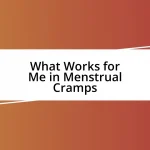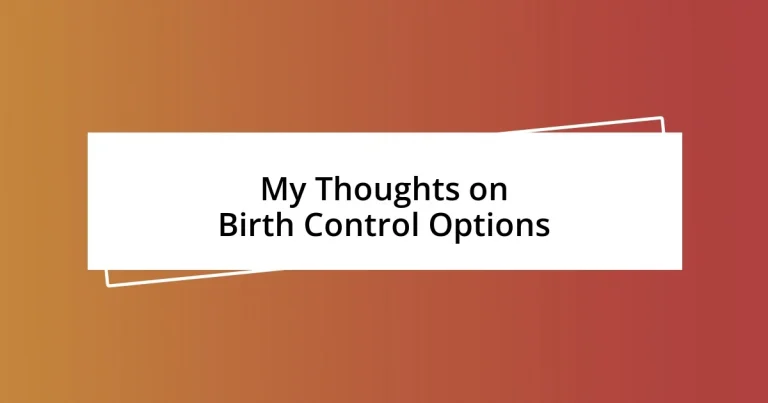Key takeaways:
- Understanding birth control is about personal empowerment and informed choices; consulting healthcare providers is crucial in navigating options.
- Different birth control methods cater to various lifestyles, with hormonal and non-hormonal options each having unique benefits and challenges.
- Addressing common misconceptions and assessing effectiveness rates can empower individuals to make informed decisions about their reproductive health.
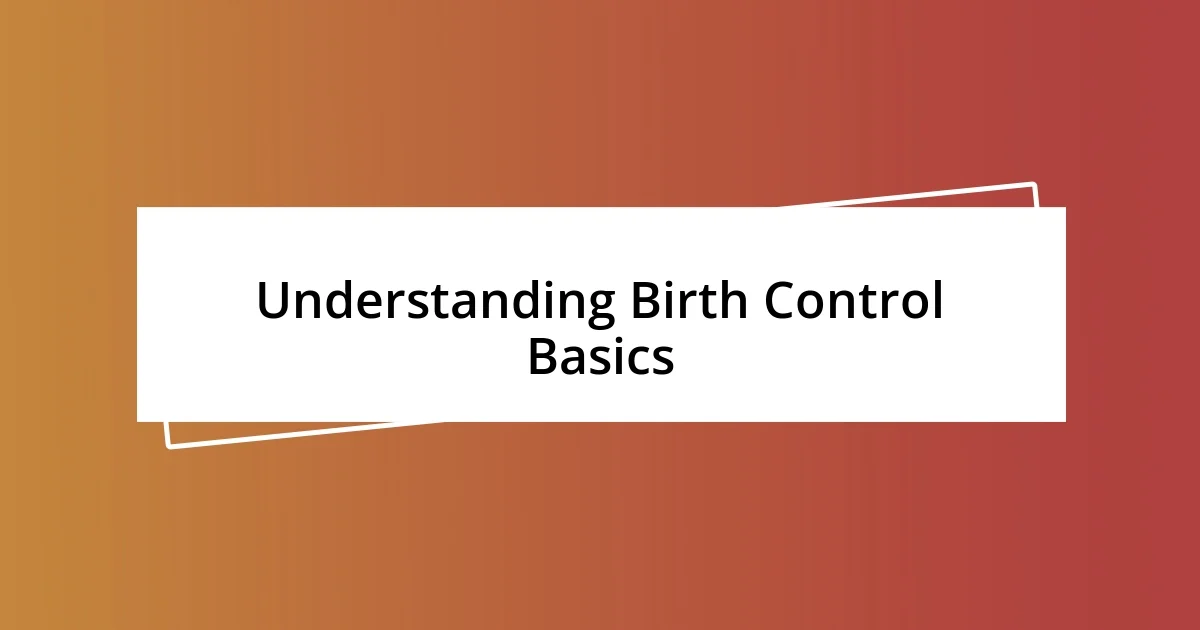
Understanding Birth Control Basics
Understanding the basics of birth control can seem daunting at first, but it’s really about finding what works best for you. I remember when I first started exploring my options; it felt overwhelming, almost like trying to choose the right book at a library where all the genres blend together. What I learned is that birth control is about more than just preventing pregnancy—it’s about empowering yourself to take charge of your reproductive health.
There are various methods available, each with its own pros and cons. For example, hormonal methods, like the pill, can regulate periods and help with acne, which I found incredibly beneficial. On the other hand, I also spoke to friends who swore by the IUD for its long-lasting solutions. Have you ever thought about how each choice reflects different lifestyles or personal beliefs? This consideration is crucial as it leads to informed and confident decisions.
What struck me the most during my journey was the importance of consulting a healthcare provider. I initially underestimated this step, thinking I could figure it all out on my own. But getting professional insights truly opened my eyes to options I hadn’t even considered. Do you feel comfortable discussing your choices with a doctor? Taking that step can make the process feel a lot less intimidating and so much more tailored to your individual needs.
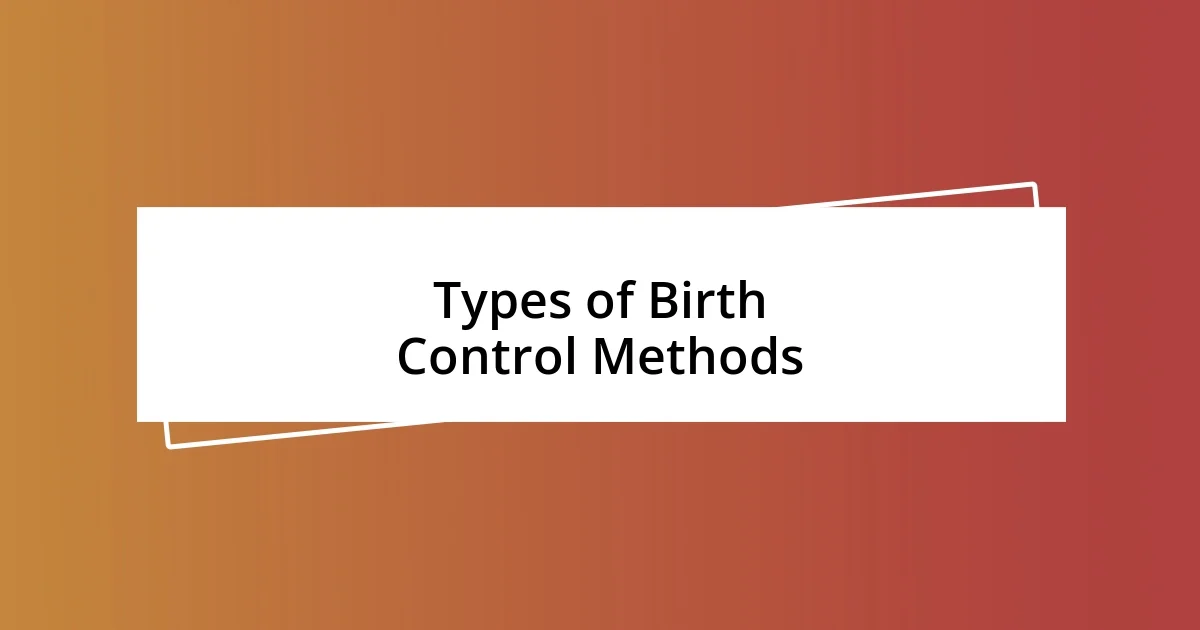
Types of Birth Control Methods
Exploring different types of birth control methods felt like diving into a world of choices. I remember sitting down with a friend, both of us surrounded by assorted pamphlets. It was eye-opening to realize how each method caters to varying lifestyles and preferences. Here’s a breakdown of some common birth control types:
- Hormonal Methods: Pills, patches, and injections that release hormones to prevent ovulation.
- Intrauterine Devices (IUDs): T-shaped devices inserted into the uterus that can last for years.
- Barrier Methods: Condoms and diaphragms that physically block sperm from reaching the egg.
- Natural Methods: Techniques like tracking cycles or abstaining during fertile periods.
- Permanent Solutions: Sterilization options for those who are certain they don’t want children.
Every choice carries a unique set of impacts. The first time I used the pill, I was excited but nervous about the adjustments my body would go through. Reflecting on that, I understand how personal each experience can be. Each method can become a different part of someone’s story, shaping not just reproductive health, but self-perception and lifestyle.
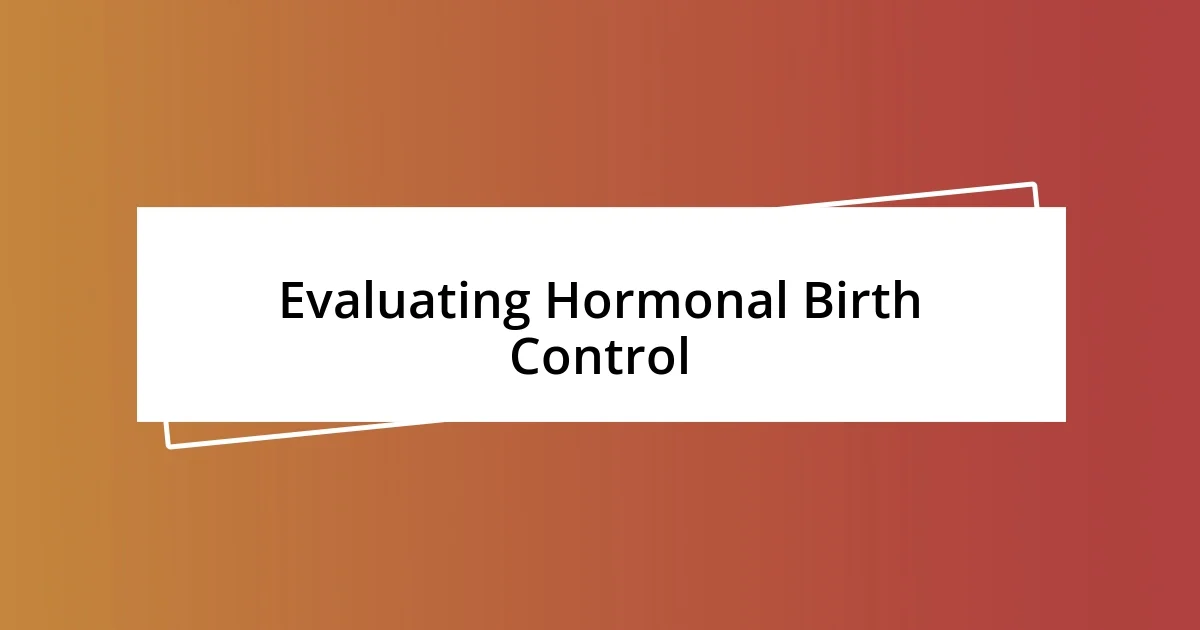
Evaluating Hormonal Birth Control
Evaluating Hormonal Birth Control can really feel like a journey, one that I found both enlightening and a bit nerve-wracking. When I first considering hormonal options, I was particularly intrigued by the pill because I had heard so many women rave about it. They talked about how it not only helps prevent pregnancy but also regulates periods. It was comforting to hear that many experienced fewer cramps and clearer skin. Have you ever felt that rush of hope when you find a solution to a problem that’s been bothering you?
However, I quickly learned that hormonal birth control isn’t a one-size-fits-all solution. I remember chatting with a friend who had a tough time with side effects like mood swings and weight gain, which made me reconsider whether the pill was right for me. It highlighted that while hormonal methods can work wonders for many, they can also manifest unwanted reactions for some. Isn’t it interesting how our bodies can respond so differently? Consulting a healthcare provider truly helped in navigating these considerations, allowing me to weigh the benefits against potential discomfort.
As I explored the various hormonal options available, I discovered the patch and the ring as alternatives to the pill. While some appreciate the convenience of the patch and the freedom it offers, others prefer the flexibility of the ring. Personally, I found the idea of not having to remember daily pills appealing, but the thought of a device like the patch on my skin made me hesitate. Ultimately, understanding my own lifestyle and feelings toward these methods made a big difference in the evaluation process.
| Type | Common Benefits |
|---|---|
| Pill | Regulates periods, helps with acne |
| Patch | Convenient to use, weekly change |
| Ring | Flexible use, monthly cycle |

Exploring Non-Hormonal Options
Exploring non-hormonal options opened my eyes to alternatives that fit my body and preferences better. I vividly recall a conversation with my sister when she mentioned the copper IUD. Unlike hormonal methods, it relies on copper to prevent fertilization, and she explained that not having to worry about hormones was a huge relief for her. Have you ever considered how refreshing it can be to use something that’s more aligned with your body’s natural rhythms?
Barrier methods, like condoms, are another avenue worth discussing. There was a time when my partner and I relied on them exclusively, and I found a certain comfort in knowing that we both shared responsibility for contraception. It’s empowering, isn’t it? Plus, I appreciated how they not only prevent pregnancy but also offer protection against sexually transmitted infections. Each time we used them, it felt like a partnership in planning our futures together.
Then there are natural methods, which can be appealing for those who prefer a more organic approach. I experimented with tracking my cycle, noting down my body’s cues. While there’s a learning curve to it, I found joy in being more attuned to my body. It made me ask myself – what if understanding my own cycle could empower me even further? Exploring non-hormonal options has taught me that there truly is a birth control method out there for everyone, each with its distinct advantages and considerations.
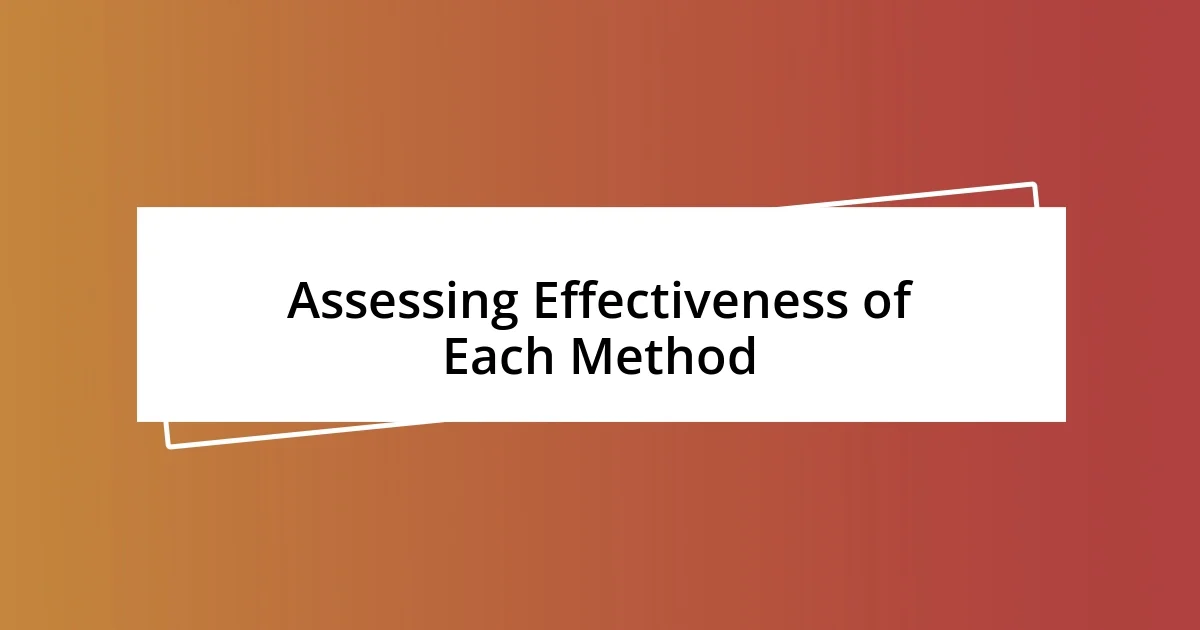
Assessing Effectiveness of Each Method
When it comes to assessing the effectiveness of each birth control method, I often find myself reflecting on the percentages associated with each option. Did you know that the pill generally has an effectiveness rate of about 99% when taken correctly? That’s impressive! However, skipping a dose or forgetting can greatly reduce its reliability. It made me curious about how easy it is for most people to maintain that consistency in their busy lives.
I remember the first time I looked into IUDs, both the hormonal and copper types. The effectiveness rates for these are pretty remarkable—over 99%! When I weighed that against the sheer thought of long-term protection without daily upkeep, I felt a wave of relief wash over me. It’s like finding a quiet corner in a busy café where you can truly focus on what’s important. But it sparked a question in my mind: could I handle the initial discomfort during placement, knowing that I’d be safeguarded for years?
Then there’s the emotional aspect tied to barrier methods. While condoms are about 85% effective with typical use, their effectiveness relies heavily on us being diligent. I recall a moment when I learned this firsthand, realizing that spontaneity sometimes clashes with that responsibility. It made me consider relationships and communication—how crucial it is to discuss and plan together. Each method has its unique story and value, and ultimately, understanding these effectiveness rates can guide us to make informed choices that resonate with our personal experiences and needs.
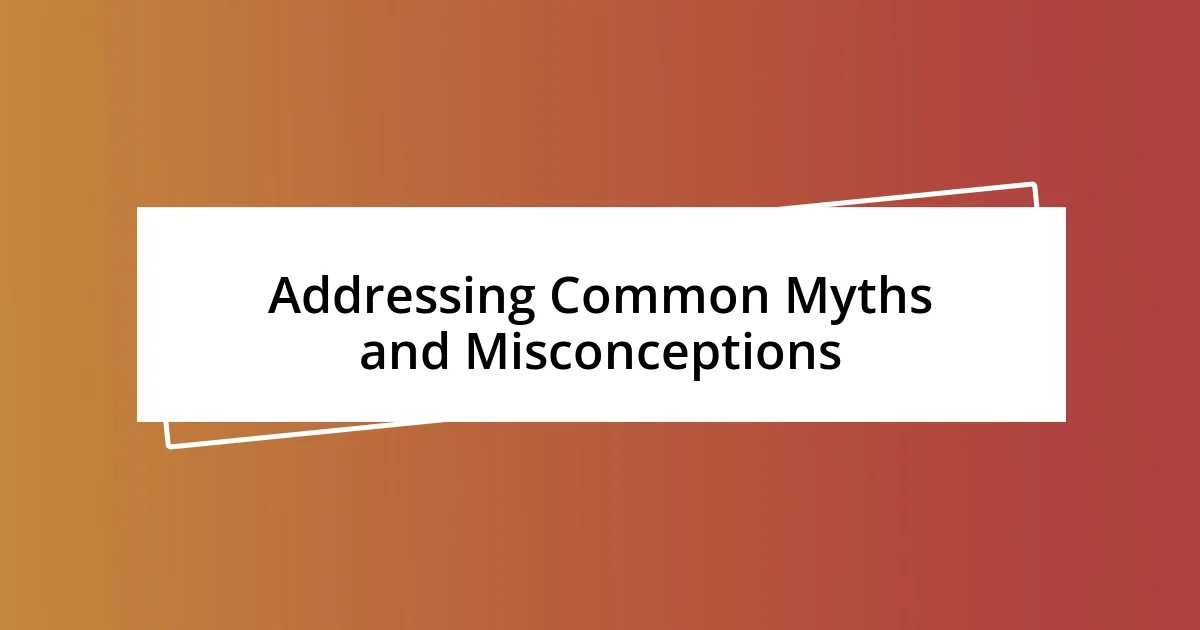
Addressing Common Myths and Misconceptions
It’s fascinating how certain myths about birth control persist in our conversations. For example, many believe that using hormonal birth control will instantly lead to weight gain. I’ve experienced fluctuations, but it made me realize that everyone’s body reacts differently. Have you ever caught yourself worrying about something that may not even be true?
Another common misconception is that natural methods lack reliability. When I started tracking my own fertility signals, I was surprised by the accuracy I achieved over time. It’s easy to dismiss natural methods as ineffective, but what if they could work if properly understood? This led me to consider the idea that education around these methods could empower more individuals to take charge of their reproductive health.
Lastly, there’s a belief that IUDs are only for those who have had children. I can’t tell you how many times I’ve heard that from friends. When I finally decided to get one, I found it liberating, dispelling that stigma in my mind. Why do we let such assumptions dictate our choices? Each experience is unique, and challenging these misconceptions allows us to make more informed and confident decisions about our bodies.

Making an Informed Decision
Making an informed decision about birth control involves diving deep into personal values and needs. I remember sifting through various options and feeling overwhelmed, but I realized that taking time to assess what truly mattered to me was essential. What does effectiveness mean in the context of my lifestyle? For instance, the freedom of long-term methods appealed to me greatly, but knowing I needed to weigh the initial discomfort against my long-term peace of mind was a real turning point.
Talking with friends who had different experiences also illuminated my own path; each story added layers to my understanding. I found it eye-opening how our individual circumstances influenced our choices—what worked for one might not work for another. It’s a reminder that there’s no one-size-fits-all approach in reproductive health. Have you had similar conversations? They can provide invaluable insight and support.
As I navigated this decision-making process, I learned the importance of consultation with healthcare professionals. Still, I felt it was just as crucial to trust my instincts. There’s a certain power in combining expert advice with personal reflection. The journey of understanding my options turned into a collaborative effort between my thoughts, experiences, and the knowledge I gained from those around me. It was all about crafting a decision that felt right for me and my life’s narrative.


